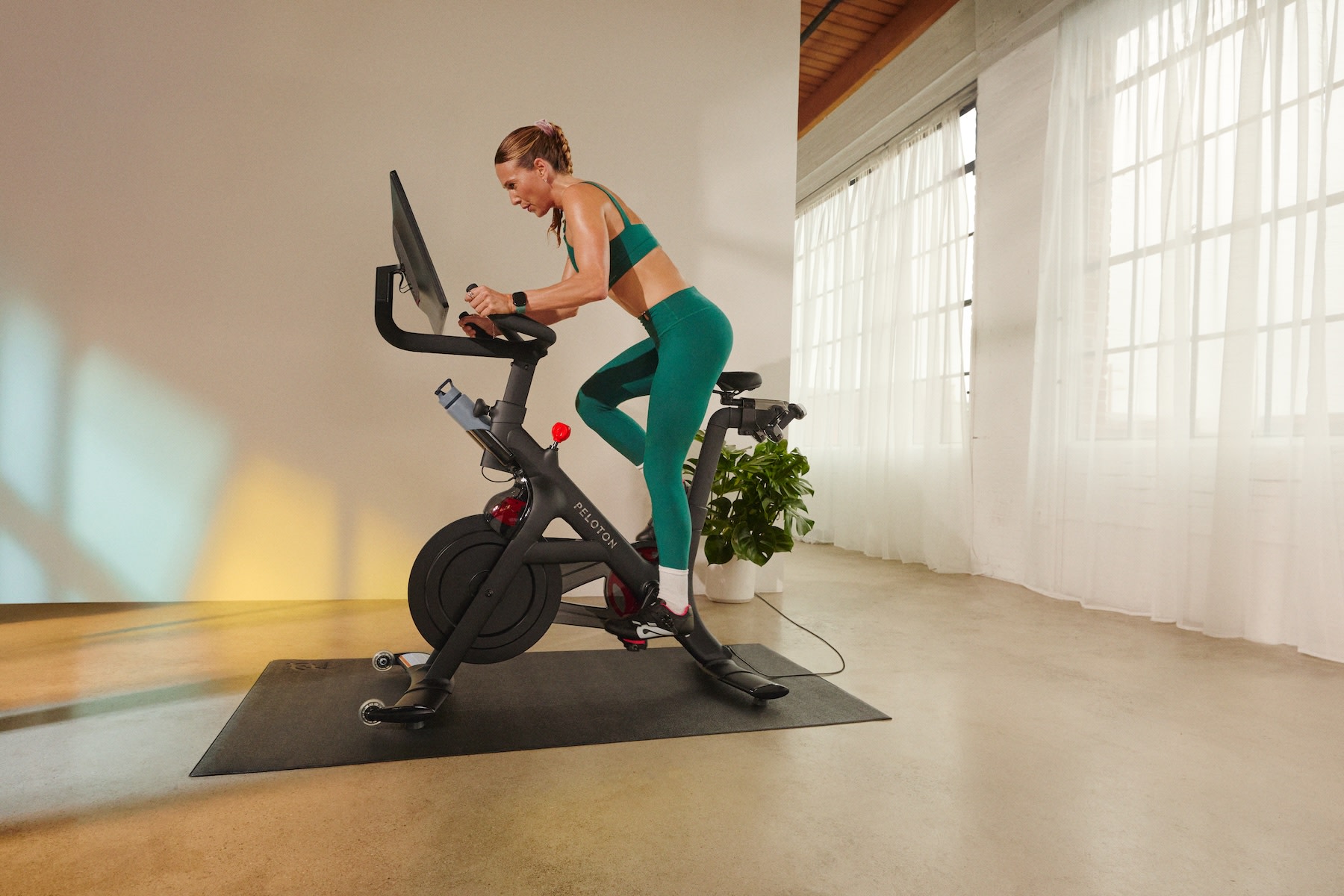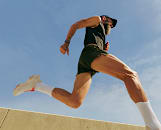
What Muscles Are You Actually Working on the Bike?
It’s more than a great cardio workout.
By Pam Moore•
What Muscles Does a Bike Work?
Indoor Cycling vs. Outdoor Riding
Does Cycling Build Muscle?
Tips for Building Strength with Cycling
Caring for Muscles Used During Cycling
Building a Balanced Routine
Thinking about taking up cycling or just looking to take your rides to the next level? Understanding which muscles cycling works can help you better prepare for your workout, recover more quickly after a session, and identify ways to make your routine more balanced. Whether you prefer to ride inside or outside, identify as a weekend warrior or a hardcore fitness enthusiast, here’s what you need to know about your cycling muscles to reach your goals—no matter what they are.
Discover more ways to reach your goals with Peloton
What Muscles Does a Bike Work?
The better question might be, “What muscles doesn’t a bike work?” Cycling engages just about every single muscle in your lower body, your core, and even parts of your upper body.
“If you’re efficient, you’re using all of your muscles,” says Ann Trombley, a physical therapist, cycling coach, and owner of Trail Master Coaching and Physical Therapy. That means exerting even, consistent pressure throughout the entire pedal stroke, not just on the downward push.
For maximum efficiency (i.e., a workout where you’re contracting all your muscles without overusing certain ones), Trombley suggests shooting for 90-110 revolutions per minute (RPM) with moderate resistance. If you’re riding a Peloton Bike or Bike+, this will show on your screen as your cadence. (Peloton’s Low Impact rides are a great option for this.)

Peloton App
Access thousands of classes with no equipment needed.
Lower Body
Your quads (the large muscles on the front of your thighs) are the number one muscles you recruit while cycling, with your glutes being number two, says Trombley.
Other leg muscles that play a role include your hip flexors, hamstrings, calf muscles (the gastrocnemius and soleus), and shins, or anterior tibialis. And when you’re out of the saddle, you also engage your hip abductors (tensor fascia latae, or TFL) and adductors (inner thigh muscles), to help keep your hips and knees stable, Trombley says.
Core
At first glance, cycling might not seem like it works your core (which includes your abdominal and back muscles), but when you look a little closer, it’s clear that it does—especially when you’re out of the saddle. “Core muscles stabilize your upper body all day, but especially when cycling out of the saddle,” says Peloton instructor Charlotte Weidenbach.
And that stabilization is key. As Trombley explains, “Your core is your platform.” This group of muscles that wraps around your abdomen is key for transferring power between your lower and upper body, and stabilizing and protecting your spine. Think about it this way: “Do you want to be a wet spaghetti noodle or a dry one?” Trombley says. “If your core is loose, then your arms and legs are not going to be efficient.”
Upper Body
If you’re hoping for a true full body workout, you’re probably wondering, “Does cycling work the upper body?” For indoor cycling, your arms aren’t getting too much action; they’re primarily responsible for helping with balance on the bike. (That is, unless you’re taking one of Peloton’s Intervals and Arms rides, which include dedicated arm exercises with light weights.)
But when you’re outside, particularly on a mountain bike, it’s a different story. Trombley calls the trapezius, rhomboids, and pectoral muscles, the “core” of your upper body, and says they, along with your triceps, are “huge for going downhill.”
Indoor Cycling vs. Outdoor Riding
When it comes to how cycling works your muscles, it doesn’t seem to make a big difference whether you’re riding indoors or outdoors. A 2019 study published in the International Journal of Sports Physiology and Performance found that while cyclists were more likely to generate more consistent power indoors versus outdoors, the environment didn’t influence their overall performance (measured as output).
That shouldn’t surprise anyone who has ridden both indoors and outdoors; both types of cycling have advantages and disadvantages from a muscle-engagement POV. Riding outside means contending with factors like wind, hills, and traffic lights, for example. Meanwhile, “in indoor cycling, you don't stop your legs during the workout, whilst outdoors, when going down a hill, you might not move your legs at all,” Dr. Charlotte says. “So indoor cycling can feel a lot tougher in a shorter amount of time.”
Another study out of the University of Nevada, Las Vegas, not only confirmed that the environment didn’t affect cycling performance; it went a step further to see whether the environment had an impact on individual hip extensor and knee flexor muscles. The authors concluded that while the rate of perceived exertion (RPE) affected muscle activity, the environment didn’t.
Meanwhile, data suggests that indoor cycling comes with plenty of health benefits, regardless of the effect on your muscles. A 2019 systematic review found that indoor cycling may improve aerobic fitness, blood pressure, and cholesterol levels.

Does Cycling Build Muscle?
Yes, cycling can help you build muscle, especially if you’re new to working out or to cycling. But it’s not the best approach if building muscle mass (aka hypertrophy) is your primary fitness goal.
Here’s why: You build muscle mass when you challenge your muscle tissue to the point where it creates microscopic damage. In response, your body repairs these muscle fibers and rebuilds them to be bigger and stronger, so they can better handle the workouts you’re taking on. As you get fitter, however, it takes increasingly more training stress to induce that kind of adaptation (a training principle known as progressive overload). If you don’t exercise and suddenly start cycling a few times a week, it would likely be enough of a challenge to stimulate initial strength gains, especially in your lower body. But if you already lift weights, a typical cycling workout may not be sufficient to challenge your muscular strength and trigger the muscle-building process.
A 2015 review of cycling research, for example, found that cycling does induce muscle hypertrophy, but at a much slower rate than resistance training. They also concluded that high-intensity interval cycling may be the best choice for triggering strength gains. In fact, a 2021 study published in the Journal of Strength and Conditioning Research found that, over 12 weeks, men and women who engaged in a short but challenging cycling workout three times per week (including a total of just four minutes of high-intensity cycling per week) experienced both increases in leg muscle size and stamina.
That said, if you’re already an avid exerciser or looking to build strength throughout your whole body, adopting a well-rounded resistance training routine is a better choice for meeting your hypertrophy goals.
The good news is that you don’t need to choose between strength training and cycling, even if you want to build muscle. A small 2017 study published in the Scandinavian Journal of Medicine & Science in Sports found that over a period of eight weeks, men who did a cycling workout immediately after their strength sessions twice a week experienced similar improvements in muscle size and strength versus those who only performed strength training. (Moreover, they also scored the added benefits of a cardio workout.)
How Long Does It Take to Build Muscle By Cycling?
How quickly and easily you build muscle through cycling is unique to each individual. It depends on a number of factors, including age, sex, athletic history, current fitness level, nutrition status, hydration, and how well you recover between sessions, says Trombley.
In general, it takes a long time to build muscle—experts say it can take from four to 12 weeks to see visible changes, and those gains will still be more pronounced with resistance training than they would be from cycling alone.
Tips for Building Strength with Cycling
Though cycling doesn’t replace resistance training, you can tweak the way you approach your cycling to optimize the strength-building power of your rides.
Be Intentional with Your Intervals
As noted above, high-intensity interval cycling seems to be a better bet for building muscle. If you do want to focus on cycling as a way to build strength, focus on very short intervals (as in 10-15 seconds) of the hardest effort you can muster at a relatively low cadence (60-80 RPM) with longer periods of easy recovery spinning (as in 3-5 minutes) between intervals. (That is, of course, if mashing the pedals at a low cadence and high resistance doesn’t aggravate your joints.) Or, consider taking a HIIT Ride on the Peloton Bike, Bike+, or App.
Don’t Push Beyond Pain
Discomfort is part of the process of getting stronger—but pain shouldn’t be. Know that riding in a hard gear at a lower cadence can increase your risk of injury. “If you’re ‘mashing,’ you’re most likely working your quads [harder than usual], which is going to pull on your kneecap. That’s going to put more pressure on your kneecap, which is then going to rub on your femur,” Trombley explains. Additionally, the outsized glute contraction that’s required of this type of riding can pull on your lower back muscles, which can set you up for lower back pain, she says.
Vary Your Workouts
To work your muscles without creating unnecessary strain, prioritize variety—consider a Climb Ride from the Peloton class library. “A great way to increase performance, especially for indoor cycling, is switching from in the saddle to out of the saddle,” Dr. Charlotte says. “You'll notice that especially when climbing (heavier resistances, lower cadences), at some point, the resistance is almost impossible to push in the saddle. At this point, when you get up, you'll be able to sustain it for a while longer, as you engage more muscles and can use your body weight to push the resistance too. This combination builds great strength endurance.”
Caring for Muscles Used During Cycling
To get the most out of your workout, it’s vital to get in both a solid warm-up and cool-down. Why? “Your warm-up gets the blood (and oxygen) flowing to help get our muscles and cardiovascular system ready to do harder work. The cooldown is also important to slowly allow the heart rate to decrease and to help clear out any waste in the muscles and blood vessels,” Trombley says.
Depending on the total duration of your workout, she suggests warming up and cooling down for 15-30 minutes, keeping your RPMs between 90 and 110, and maintaining an RPE of two to four. And according to the research, you don’t need to sweat the details of your warm-up too much. One study found that cyclists performed significantly better after both a hard warm-up and an easy warm-up versus no warm-up at all.
If you’re on a Peloton Bike or Bike+ or using the Peloton App with your own equipment, be sure to check out the cycling-specific Warm Up and Cool Down classes.
Building a Balanced Routine
Sure, the best way to become a better cyclist is to get on your bike and ride, but being a strong, sustainable cyclist requires balance. That means including cross-training and plenty of recovery in your routine.
Strength Training
Trombley suggests strength training to optimize your fitness and prevent injury. That might look like doing two sets of a weight you can handle for 12-15 reps and working toward two to three sets of five to eight reps at a heavier weight. If you’re training outdoors, shoot for three sessions a week during your off-season and once or twice a week during peak season.
Core Work
Core work is also essential. Moves like planks and plank variations are great. To spice things up, Charlotte recommends the Copenhagen plank, which is essentially a side plank with your upper leg supported on a chair or weight bench. “This will burn the core and adductors,” which offers a ton of bang for your buck, she says.
Whatever you do, do it consistently. Charlotte recommends doing at least ten minutes of core exercises twice a week to optimize performance and prevent back pain.
Recovery
Trombley suggests prioritizing massage, whether that means going to a massage therapist or engaging in self-massage with a foam roller, tennis ball, or massage gun. She also says stretching can be helpful, whether that’s on your own or in a gentle yoga or stretching class on the Peloton App.
Active recovery is vital, too, says Charlotte. Instead of doing hard sessions on consecutive days, follow an intense workout with an easier one. Charlotte suggests “a low-impact workout with the goal to increase the heart rate and the blood flow through your muscles without working them hard. For cycling, this means a high-cadence, low-resistance ride that gets you breathing faster without being completely out of breath. It can also be a longer walk or swim.”
Meanwhile, Trombley reminds us to keep the basics in mind. All the massage in the world can’t make up for underfueling, dehydration, or skimping on sleep.
And according to Trombley, the importance of recovery skyrockets as we age. If you’re noticing that at 40 or 50 you just can’t do what you used to do, start paying attention to your body’s cues. That might mean taking more days between your hard workouts, keeping your workouts a little shorter, or even prioritizing naps.
Related Articles
This content is for informational and educational purposes only and does not constitute individualized advice. It is not intended to replace professional medical evaluation, diagnosis, or treatment. Seek the advice of your physician for questions you may have regarding your health or a medical condition. If you are having a medical emergency, call your physician or 911 immediately.
Explore Peloton Bikes
Level up your inbox.
Subscribe for a weekly dose of fitness, plus the latest promos, launches, and events.
By providing your email address, you agree to receive marketing communications from Peloton.
For more about how we use your information, see our Privacy Policy.















